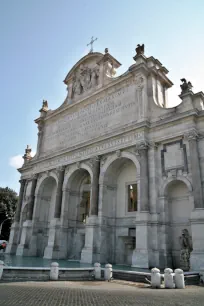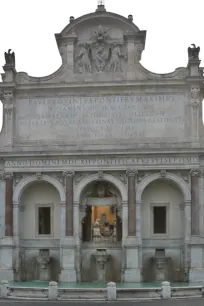Situated atop the Janiculum Hill, the Fontana dell’Acqua Paola is one of the so-called «Mostra terminale»: fountains that were built at the end of an aqueduct. The fountain is also one of the largest fountains in Rome. It is locally known as «Il Fontanone»: The Big Fountain.
The aqueduct of Trajan

In 1608, at the behest of Pope Paul V Borghese, work started on the restoration of an old Roman aqueduct that was built in 109 AD, during the reign of Emperor Trajan. The aqueduct brought fresh water from a spring near the Bracciano Lake in the hills surrounding Rome all the way to the Trastevere neighborhood, over a distance of about 56 kilometers (35 miles). The aqueduct was renamed Acqua Paola, after the pope’s name (Paolo is Italian for Paul).
The pope wanted to crown this restored aqueduct with a monumental fountain at its terminus. The new fountain was constructed by the Ticinese architect Giovanni Fontana, with the help of Flaminio Ponzio. Fontana, whose brother Domenico had built the Fontana Dell’Acqua Felice (better known as the Fountain of Moses) twenty years earlier, was instructed to build a similar, monumental fountain.
The Fountain


The fountain was constructed between 1610 and 1612 with white and polychrome marble taken from buildings on the Roman Forum and the Temple of Minerva at the Forum of Nerva, which up to that point was still nearly intact. It shows three large central arches flanked by two smaller ones. The arch in the middle is open and allows you to see into the small courtyard behind the fountain. The arches are divided by red granite columns in Ionic order, that were taken from the old St. Peter’s Basilica, which at the time was being reconstructed. Water flows through each of the three central arches into small basins. The two smaller arches feature water spouts.
Above the arches is the attic which bears an inscription in Latin that dedicates the fountain to Pope Paul V. Interesting here is that there is a mistake in this description since it incorrectly refers to the aqueduct as the Aqua Alsietina, an aqueduct built by Emperor Augustus.
At the top of the fountain is the sculpted coat of arms of Pope Paul V Borghese: it shows the papal tiara with the keys of St. Peter above a dragon and an eagle (both symbol of the House of Borghese), flanked by two angels. The sculptures were the work of Ippolito Buzio, a Lombard sculptor.
At the time of construction, the fountain was located on the edge of a hill, and water cascaded from the basins down like a waterfall. The current square we see in front of the fountain was created in 1690 on order of Pope Alexander VIII. At the same time, architect Carlo Fontana created the large pool below the basins. The balustrade around the pool was added eight years later to prevent people from watering their horses here.
The fountain was damaged during the French siege of Rome in 1849. The damage was restored ten years later. Several more restorations have been undertaken since, the most recent dates from 2002-2004.

